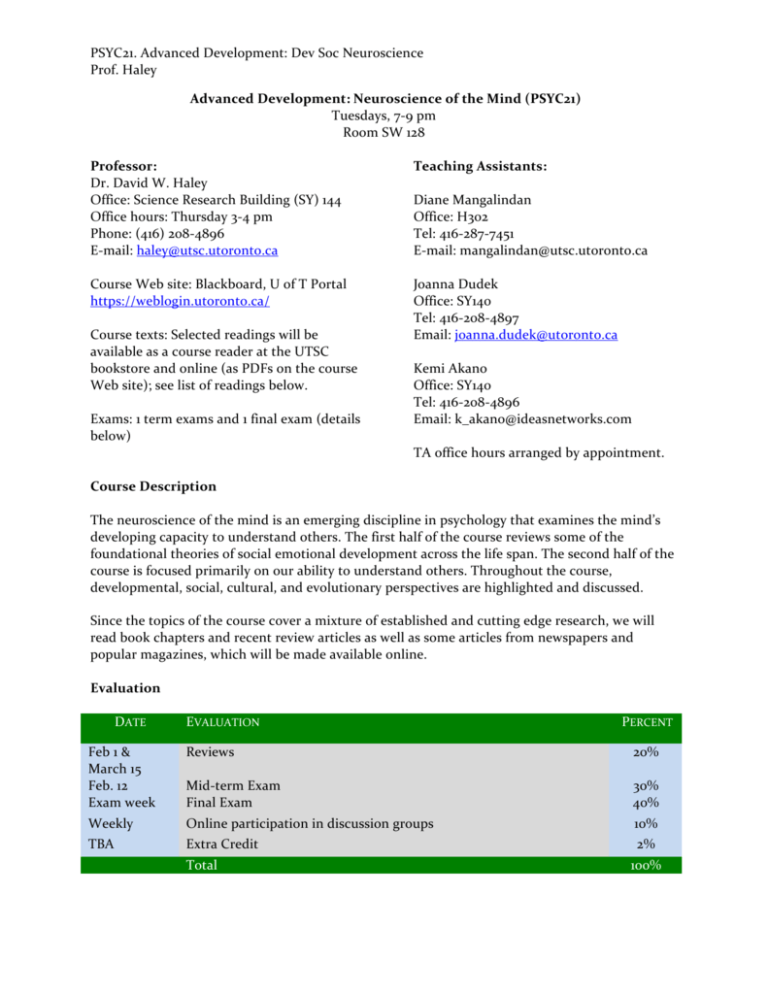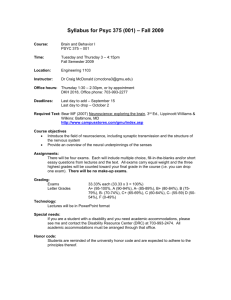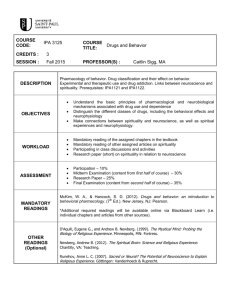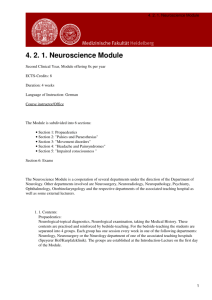PSYC21, Haley - University of Toronto
advertisement

PSYC21. Advanced Development: Dev Soc Neuroscience Prof. Haley Advanced Development: Neuroscience of the Mind (PSYC21) Tuesdays, 7-­‐9 pm Room SW 128 Professor: Teaching Assistants: Dr. David W. Haley Office: Science Research Building (SY) 144 Diane Mangalindan Office hours: Thursday 3-­‐4 pm Office: H302 Phone: (416) 208-­‐4896 Tel: 416-­‐287-­‐7451 E-­‐mail: haley@utsc.utoronto.ca E-­‐mail: mangalindan@utsc.utoronto.ca Course Web site: Blackboard, U of T Portal Joanna Dudek https://weblogin.utoronto.ca/ Office: SY140 Tel: 416-­‐208-­‐4897 Course texts: Selected readings will be Email: joanna.dudek@utoronto.ca available as a course reader at the UTSC bookstore and online (as PDFs on the course Kemi Akano Web site); see list of readings below. Office: SY140 Tel: 416-­‐208-­‐4896 Exams: 1 term exams and 1 final exam (details Email: k_akano@ideasnetworks.com below) TA office hours arranged by appointment. Course Description The neuroscience of the mind is an emerging discipline in psychology that examines the mind’s developing capacity to understand others. The first half of the course reviews some of the foundational theories of social emotional development across the life span. The second half of the course is focused primarily on our ability to understand others. Throughout the course, developmental, social, cultural, and evolutionary perspectives are highlighted and discussed. Since the topics of the course cover a mixture of established and cutting edge research, we will read book chapters and recent review articles as well as some articles from newspapers and popular magazines, which will be made available online. Evaluation DATE EVALUATION PERCENT Feb 1 & March 15 Feb. 12 Exam week Reviews 20% Mid-­‐term Exam Final Exam 30% 40% Weekly Online participation in discussion groups 10% TBA Extra Credit 2% Total 100% PSYC21. Advanced Development: Dev Soc Neuroscience Prof. Haley Schedule and Readings Meetings Topics Jan 11 Introduction I Developmental Neuroscience of Mind: Methods and questions Jan 18 Introduction II Why do humans have such big brains? Description *Main Readings deHaan & Gunnar (2009) Dunbar & Shultz (2007) Cassidy (2002) Attachment I Overview of attachment theory and research Feb 1 Attachment II Theoretical bridges between attachment and theory of mind Cortina & Liotti (2010) Feb 8 Mid-­‐term Review An optional review will be provided in class. Exam date and location TBA. -­‐-­‐-­‐-­‐-­‐-­‐-­‐-­‐ Jan 25 Feb 15 Social Mind I Reading Week No class Feb 22 March 1 March 8 Social Mind II Competing theories about the developmental origins of intersubjectivity Social Brain I March 15 Social Brain II March 22 March 29 Memory April 5 The evolutionary and developmental origins of social communication. Final Exam Review Myowa-­‐ Yamakoshi & Tomonaga (2009) -­‐-­‐-­‐-­‐-­‐-­‐-­‐-­‐-­‐-­‐-­‐-­‐-­‐-­‐ Week 1 2 3 4 5 6 7 Gallagher (2008) 8 The neuroscience of empathy and emotion: The mirror neuron system Gallese (2009) 9 The neuroscience of empathy: I feel your pain Mundy (2011) 10 11 Bauer (2011) 12 -­‐-­‐-­‐-­‐-­‐-­‐-­‐-­‐ 13 No class (professor is out of town for a conference) The development of memory systems have been linked to development of the brain An optional review will be provided in class. Exam date and location TBA. *Readings available on the course web site PSYC21. Advanced Development: Dev Soc Neuroscience Prof. Haley Reviews: Each student will be responsible for writing reviews of two of the weekly reading assignments (not including the occasional New York Times articles). You may choose any of the weekly reading for your reviews. The goal of the written reviews is to provide both an interesting summary of and a critical reflection on the chosen readings. Each review should consist of two double-­‐spaced pages. The first page should provide the summary component (weighted 50%), and the second page should consist of the critical reflection component (weighted 50%). The summary component should be relatively straightforward, although figuring out how to summarize the most interesting and essential points in a single page requires some talent and time. The critical reflection component is more challenging and will require more thought and time than the summary. One way to begin to reflect critically on a reading is to consider the following questions: 1) What is the reading trying to demonstrate (main ideas, assumptions, models, methods)? 2) How convincing is it (evidence, arguments used, logic, consistency)? 3) What significance does it have to society (what are its applications, usefulness, and ethical implications)? Reviews are due at the end of class. Reviews will not be accepted late unless you can provide me with a UTSC medical note. Online participation: We will hold an online discussion forum on Blackboard. The goal of the discussion is for students to raise and answer important questions that relate to the readings and lectures. Ideally, students will alternate between raising and answering questions. Comments are also encouraged; these may include discussions of real-­‐life applications of the material and of additional studies that support existing or alternative understandings. Each week the TAs will report to me some of the major points that have been raised that week in the Blackboard discussion, and I will briefly summarize them in class to provide feedback on and address questions raised there. These in-­‐class reviews will provide an opportunity to raise new questions based on the readings and lecture, which in turn should stimulate further discussion online. To participate online, you will need to be registered on Blackboard. To receive full credit for participation, each student should plan to post every week. Midterm and Final Exams: The midterm and final exams will consist of True/False and multiple choice questions along with a few short answer and long essay questions. Practice questions for the exam will be posted on Blackboard. Extra Credit (up to 2%): Generating your own exam questions and preparing answers for them is a good way to learn the course material, and some of the best questions for exams come from students. Accordingly, from anyone who would like extra credit, I will accept five exam questions, each of which should have a ¼-­‐ to ½-­‐page answer; these questions must be received by me no later than one week prior to the midterm or final exam. For more information about this option please speak a TA. I will grant up to (and a maximum of) 2% extra credit to students who complete these assignments. Course Web Site: I will make the syllabus and all readings, lecture notes, announcements, and exam review materials available on the course Web site (log in to the U of T Blackboard portal at https://weblogin.utoronto.ca/). Please check this Web site regularly for announcements and messages. Also, please ensure that your current e-­‐mail address is correctly linked to your Blackboard account. PSYC21. Advanced Development: Dev Soc Neuroscience Prof. Haley Getting Help with Course Materials: If your question is not answered here in this syllabus or on the course Web site, you may post the question in the online discussion forum (on Blackboard; see above), bring the question to the TAs’ weekly office hours, or discuss it with me during my office hours. You may also send an email to one of our TAs, but please allow two working days’ time for a reply. Major questions relating to course content can be addressed in far greater depth in person. Developmental Neuroscience Tutorials: Because this course covers material on both psychological development and biology, we will hold 3 or 4 in-­‐class biology tutorials that will be designed to highlight key material you will need to master concerning genes, hormones, and neurotransmitters. The biology tutorials will be led by the TAs based on material discussed in lecture and in the readings. Exams: Course requirements include two cumulative exams: one mid-­‐term exam and one final exam. The mid-­‐term exam is worth 30% of your total course grade, the final exam worth 40%. I will post short exam review sheets and sample test questions on the course Web site at least a week before the exams. Each exam will comprise approximately 75% multiple-­‐choice questions and 30% short answer questions and will cover reading and lecture materials. Missed Exams: If you provide valid, verifiable medical documentation on a UTSC Student Medical Certificate that documents your reason for missing the mid-­‐term exam, I will re-­‐weight your final exam so that it is worth 60% instead of 30%. Except in the case of an unforeseen, same-­‐ day emergency, you must notify me or one of the TAs more than 24 hours before the start of the midterm exam in order to be eligible for this re-­‐weighting. If you miss the final exam, the procedure is different, and you must contact the UTSC Registrar's Office; professors and TAs are not authorized to negotiate changes to the final exam schedule. Please consult the university calendar for more information. AccessAbility: Students with diverse learning styles and needs are welcome in this course. In particular, if you have a disability/health consideration that may require accommodations, please feel free to approach me and/or the AccessAbility Services Office as soon as possible. I will work with you and AccessAbility Services to ensure you can achieve your learning goals in this course. Enquiries are confidential. The UTSC AccessAbility Services staff (located in S302) are available by appointment to assess specific needs, provide referrals and arrange appropriate accommodations (416) 287-­‐7560 or ability@utsc.utoronto.ca. Academic Integrity: Academic integrity is essential to the pursuit of learning and scholarship in a university, and to ensuring that a degree from the University of Toronto is a strong signal of each student’s individual academic achievement. As a result, the University treats cases of cheating and plagiarism very seriously. The University of Toronto’s Code of Behaviour on Academic Matters (http://www.governingcouncil.utoronto.ca/policies/behaveac.htm) outlines the behaviours that constitute academic dishonesty and the processes for addressing academic offences. Potential offenses include, but are not limited to: In papers and assignments: -­‐Using someone else’s ideas or words without appropriate acknowledgement. -­‐Submitting your own work in more than one course without the permission of the instructor. PSYC21. Advanced Development: Dev Soc Neuroscience Prof. Haley -­‐Making up sources or facts. -­‐Obtaining or providing unauthorized assistance on any assignment. On tests and exams: -­‐Using or possessing unauthorized aids. -­‐Looking at someone else’s answers during an exam or test. -­‐Misrepresenting your identity. In academic work: -­‐Falsifying institutional documents or grades. -­‐Falsifying or altering any documentation required by the University, including (but not limited to) doctors' notes. All suspected cases of academic dishonesty will be investigated following procedures outlined in the Code of Behaviour on Academic Matters. If you have questions or concerns about what constitutes appropriate academic behaviour or appropriate research and citation methods, you are expected to seek out additional information on academic integrity from your instructor or from other institutional resources (see http://www.utoronto.ca/academicintegrity/resourcesfor students.html). Readings Week 1 de Haan, M., and M. R. Gunnar (2009). The Brain in a Social Environment: Why Study Development? In M. de Haan and M. R. Gunnar, eds., Handbook of Developmental Social Neuroscience (New York: Guilford Press), 3-­‐10. Week 2 Dunbar, R. I. M., and S. Shultz (2007). Evolution in the Social Brain, Science 317, 1344-­‐47. Week 3 Cassidy, J. (2002). The Nature of the Child's Ties. In J. Cassidy and P. R. Shaver, Handbook of Attachment: Theory, Research and Clinical Applications (New York: Guilford Press), 3-­‐20 Week 4 Cortina, M., and G. Liotti (2010). Attachment is About Safety and Protection, Intersubjectivity is About Sharing and Social Understanding: The Relationships Between Attachment and Intersubjectivity, Psychoanalytic Psychology, 27, no. 4, 410–441. Week 5 No reading (mid-­‐term exam) Week 6 Myowa-­‐Yamakoshi, M. and M. Tomonaga (2009). Evolutionary Origins of Social Communication, in Handbook of Developmental Social Neuroscience (New York: Guilford Press), 207-­‐221. PSYC21. Advanced Development: Dev Soc Neuroscience Prof. Haley Week 7 No reading (UTSC reading week) Week 8 Gallagher, S. (2008). Inference or Interaction: Social Cognition without Precursors, Philosophical Explorations 11, no. 3, 165-­‐74. Week 9 Gallese, V. (2009). Mirror Neurons, Embodied Simulation, and the Neural Basis of Social Identification, Psychoanalytic Dialogues 19, no. 5, 519-­‐536. Week 10 Mundy, P. (2011). Neural Connectivity, Joint Attention, and the Social-­‐Cognitive Deficits of Autism. In M. Legerstee, D. W. Haley, M. H. Bornstein (Eds.), The Developing Infant Mind: Integrating Biology and Experience. New York: Guilford. Week 11 No class (professor is out of town for a conference) Week 12 Bauer, P. (2011). Neural correlates of memory development. In M. Legerstee, D. W. Haley, M. H. Bornstein (Eds.), The Developing Infant Mind: Integrating Biology and Experience. New York: Guilford. Week 13 No reading (final exam) Supplemental Readings Angier, N. (2008). About Death, Just Like Us or Pretty Much Unaware? New York Times, September 2, pages 1-­‐3. Blakeslee, S. (1995). Behind the Veil of Thought: Advances in Brain Research; In Brain's Early Growth, Time Table May Be Crucial. New York Times, August 29, 1995, 1-­‐10. Buckley, C. (2007). Why Our Hero Leapt onto the Tracks and We Might Not. New York Times, January 7, 2007, 1-­‐2. Damasio, A. (2010). Self Comes to Mind: Constructing the Conscious Brain. Pantheon: New York. Gallese, V. (2003). The manifold nature of interpersonal relationships: The quest for a common mechanism. Phil. Trans. R. Soc. London 358: 517-­‐528. Goldberg, C. (2006). Empathy may begin at the neurons. New York Times, December 14, 2006, 1-­‐3. PSYC21. Advanced Development: Dev Soc Neuroscience Prof. Haley Gopnik, A. (2007). Cells That Read Minds? What the Myth of Mirror Neurons Gets Wrong about the Human Brain. Slate, April 26, 2007, 1-­‐4. Iacoboni, M., video discussion of mirror neurons and how we understand others, http://www.youtube.com/watch?v=ESM7b-­‐X8zhQ&feature=related. Johnson, M. (2011). Building a Brain. In M. Johnson, Developmental Cognitive Neuoroscience (London: Wiley-­‐Blackwell), 42-­‐80. Markova, G., and M.Legerstee (2008). How Infants Come to Learn about the Minds of Others. Zero to Three, May, 2008, 26-­‐31. National Geographic: Mapping Memory, http://ngm.nationalgeographic.com/2007/11/memory/brain-­‐interactive. Schmidt, L. A., and M. K. Jetha (2009). Temperament and Affect Vulnerability: Behavioral, Electrocortical, and Neuroimaging Perspectives. In M. De Haan & M. R. Gunnar, eds., Handbook of Developmental Social Neuroscience (New York: Guilford Press), 305-­‐23.





